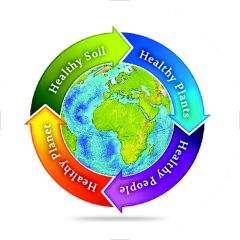Vermicast (worm manure) is natural topsoil.
But it’s way beyond just mere soil.
Have you ever stopped to consider what makes some soils different than others?
Have you ever stopped to consider where many vitamins comes from?
What about natural antibiotics?
Or flavonoids, which create “taste” and “flavor”?
Or enzymes, which are necessary catalysts for cell production?
The answer to all the above is, soil microorganisms.
Bacteria and fungi.
Plus, bacteria and fungi make up a large part of the diets of earthworms.
Thus vermicast is generally fuller and richer in vitamins, natural antibiotics, flavonoids, and enzymes.
All the things that make food great.
Many vitamins are either created, or bioactivated by processes involving interactions of bacteria and fungi, often in conjunction with enzymes.
Even where it was once thought that Vitamin D was created by the skin from sunlight, more recent studies and research is showing it is actually the microbiome on & in the skin that is synthesizing that vitamin D (it’s been shown that for every human skin cell, there are some 9 microorganisms present).
Most all natural antibiotics known to humans are created by soil microorganisms, often in conjunction with enzymes.
Those natural antibiotics are defense mechanisms, a form of chemical warfare as groups of microorganisms battle other groups of microorganisms.
Plus, whereas antibiotic resistance among bacteria from lab-created antibiotics has become a major concern, natural antibiotics undergo rapid evolutions, mutations in response to evolving & mutating bacteria, as they develop a resistance to former antibiotics.
Nature responds to natural changes.
But humans can’t keep up in the lab.
Flavonoid production too has been shown to originate via the aid of bacteria and fungi.
In particular, E. coli has been studied, and used, extensively for it’s ability to synthesize flavonoids.
Plant flavonoids continue to find increasing use in pharmaceutical and nutraceutical applications.
Flavonoids are a type of polyphenol, often known as “bitters” and/or “aeromatic compounds”.
These bitters/aeromatic compounds have been used extensively throughout history in herbal & natural medicines (consider the use of Quinine against Malaria, or Eucalyptus against bronchial and sinus problems).
Enzymes too are created by microorganisms.
Enzymes are proteins that exist within cell walls.
Almost all metabolic processes in the cell need enzyme catalysis in order to occur at rates fast enough to sustain life.
It has often been said that the ancient “Father of Medicine, Hippocrates, said:
“Let food be thy medicine and medicine be thy food.”
Though this has also been frequently cited as being misattributed to Hippocrates, in line with Hippocrates’ philosophy, there is a complementarity of nutrition and pharmacology.
Some prefer to phrase it as “You are what you eat”.
Better building blocks equals better structures.
Foods that are richer in vitamins, natural antibiotics, flavonoids, and enzymes are much healthier than those lacking, or without.
Going back to that adage, “You are what you eat”, that goes across the entire food chain.
Better & healthier microorganisms create better soils.
Better soils create better & healthier plants.
Better & healthier plants create better & healthier bodies.
Everything is interconnected.
That is the main philosophy behind NatureSoil Products, and the high-grade products we create.
